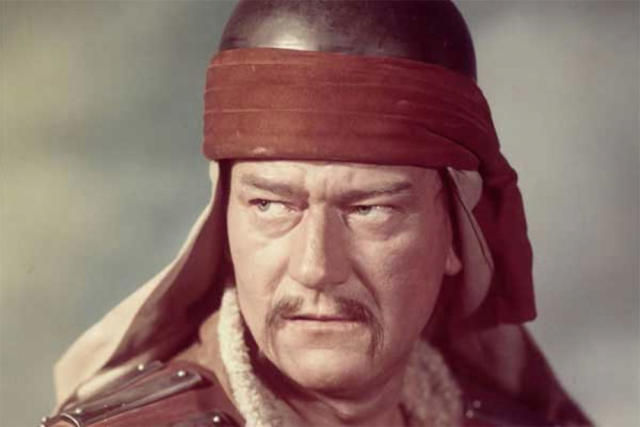In Hollywood history, there have been movies that have ruined careers, bankrupted studios, and even caused loss of life.
However, there is one movie that stands out as the epitome of toxicity – d–k Powell's 1956 epic ‘The Conqueror'.
This film, which was miscast and directionless, forever tarnished the reputation of its star, John Wayne, led to the downfall of RKO Pictures, and potentially contributed to the deaths of many cast and crew members.
Its impact was felt for decades after its release.
To understand how ‘The Conqueror' became such a disaster, we need to delve into the series of bad decisions that led to its production.
The script, written by Oscar Millard, who had previously worked on acclaimed Robert Mitchum movies, was originally intended for Marlon Brando.
However, by chance, John Wayne stumbled upon the script while visiting filmmaker d–k Powell's office.
Wayne, a celebrated cowboy actor, decided to take on the role of Temujin, the Asian warlord, despite Powell's doubts about his suitability for the part.
At that time, it was not uncommon for American actors to play foreign characters, so Wayne's casting did not raise any eyebrows.
He underwent a transformation using rubber bands to slant his eyes, ‘yellowface' makeup to alter his appearance, and a ‘Fu Manchu' style moustache and beard to give him an Asian look.
Unfortunately, Wayne's attempt to take the role seriously backfired, as he crash dieted and later received a Golden Turkey award posthumously.
Out of the entire cast, only two actors were of Asian descent, and only one of them had any dialogue.
Navajo extras were used to portray Mongolian warriors without the benefit of makeup.
The movie was financed by Howard Hughes, who provided a budget of around $6 million.
Hughes decided to film ‘The Conqueror' in Snow Canyon, Utah, a picturesque location with one major drawback – it was downwind from the Yucca Flats in Nevada, where 11 atom bombs had recently been tested.
Although Hughes and Powell were aware of the nuclear tests, they were assured by the government that the radiation would not harm the cast and crew.
As filming progressed, it became evident that Wayne struggled with the dialogue, which did not suit his Western drawl.
Powell's confidence in the movie waned, leading to a decline in quality control.
Wayne, under the influence of amphetamines to cope with the intense heat, began behaving erratically.
Unscripted scenes made their way into the final cut, including a dancing bear, Lee Van Cleef dancing shirtless, and a dangerous encounter involving a black panther nearly mauling lead actress Susan Hayward.
For 13 weeks, the cast and crew endured grueling conditions in Snow Canyon.
However, due to the exclusive use of this location for external shots, several scenes meant to depict travel actually started and ended in the same place.
When production moved back to Hollywood, Hughes insisted on shipping 60 tons of Utah dirt to match the terrain of the external shots.
‘The Conqueror' failed to conquer anything.
Even before its release, it had gained a reputation as a flop, earning a mere $4.5 million at the box office.
Wayne despised the movie and regretted ever picking up the script.
He publicly stated that the lesson he learned was not to take on unsuitable roles.
The financial failure of the film dealt a significant blow to RKO Pictures, leading to the studio's closure in 1957.
However, the true horror of ‘The Conqueror' lay in its aftermath.
It soon became apparent that the government's assurances about the safety of the nuclear tests were false.
Half of the residents of St. George, Utah, near the filming location, developed cancer due to radiation exposure.
Numerous cast and crew members also succumbed to cancer in the years following the movie's production.
Pedro Armendáriz, one of the co-stars, was diagnosed with kidney cancer and tragically took his own life upon learning it was terminal.
Director d–k Powell died from cancer, and even the three lead actors, John Wayne, Susan Hayward, and Agnes Moorhead, all succumbed to the disease in the 1970s.
Even individuals who had only visited the set were found to have a higher risk of cancer.
John Wayne's own children developed cancer after spending just one day on the Utah set.
A People Magazine investigation revealed that by the end of 1980, out of the 220 people involved in the movie, 91 had developed cancer, with 46 of them dying from the disease.
Dr. Robert Pendleton, a biologist at the University of Utah, stated that the high number of cancer cases could be directly linked to exposure on the set.
Despite mitigating factors like Wayne's heavy smoking habit, the disproportionate number of cancer cases cannot be ignored.
The Pentagon's Defense Nuclear Agency indirectly acknowledged the government's responsibility for allowing filming in Snow Canyon.
‘The Conqueror' became a literal toxic nightmare, leaving a devastating impact.
Howard Hughes was haunted by the decisions he had made.
He admitted feeling guilty about the cancer controversy and purchased all existing prints of the movie for $12 million to prevent its circulation.
Hughes became obsessed with the film, watching it repeatedly in his final days, with the projectionist wearing a blindfold as ordered by Hughes.
It wasn't until 1979, three years after Hughes' death, that Universal acquired the rights to ‘The Conqueror', which had not been seen by the public for 21 years.
Despite Hughes' attempts to bury it and Wayne's disowning of it, ‘The Conqueror' was an irredeemably bad film, conceived irresponsibly and plagued by hubris and ego.
Its legacy left a trail of bodies and scars on Hollywood that would last for decades.































